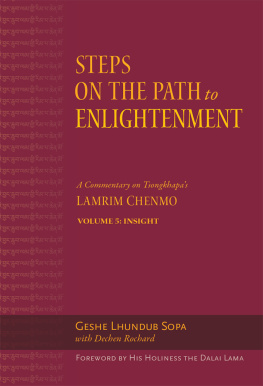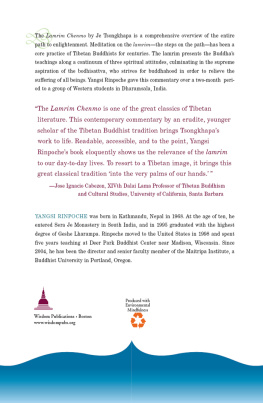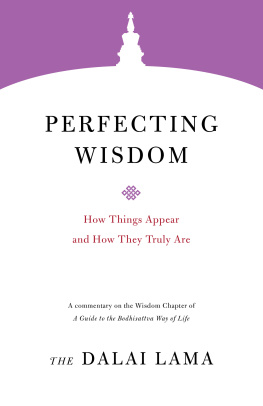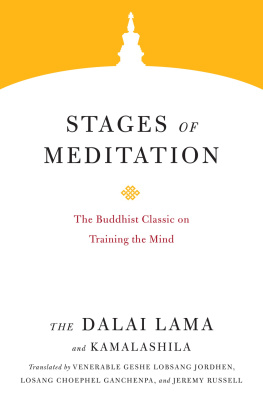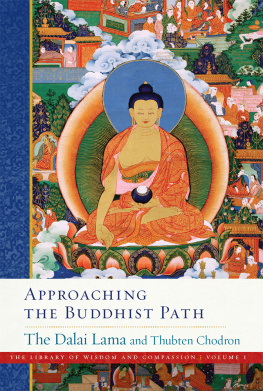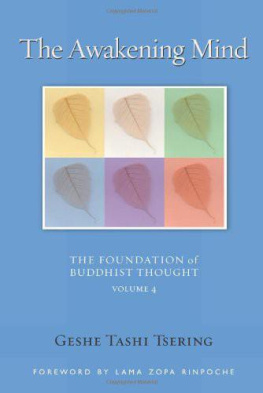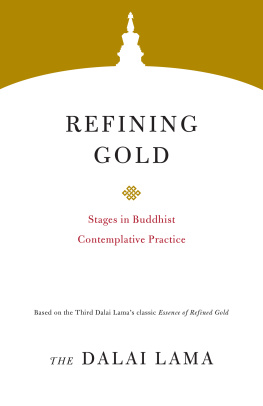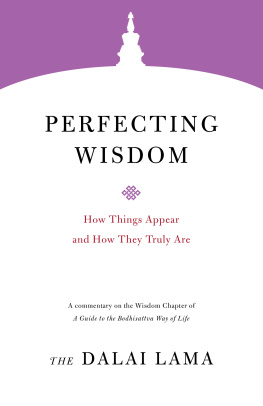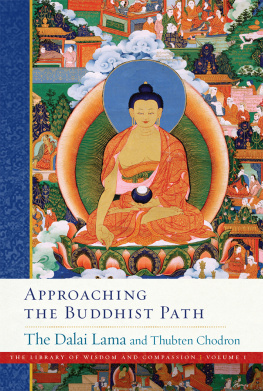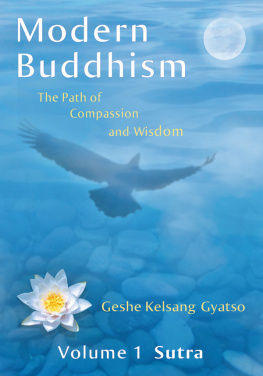The final installment of the Steps on the Path to Enlightenment series examines the nature of reality with a master class in Buddhist Middle Way philosophy and meditation.
G ESHE LHUNDUB SOPAS Steps on the Path to Enlightenment is a landmark commentary on what is perhaps the most elaborate and elegant Tibetan presentation of the Buddhist path, the Lamrim Chenmo of Tsongkhapa (13571419). This volume is the fifth and final volume transmitting a twenty-year discourse on this monumental work that Geshe Sopa delivered to his Western students. Unrivaled in its comprehensiveness, the graduated series of teachings is meant to be studied, contemplated, and finally absorbed within meditation until the mind and heart are cleared of their obscurations and the practitioner perfects wisdom and compassion in the state of full enlightenment.
In this volume, Geshe Sopa explains the practice of superior insight (vipayan), or wisdom, the pinnacle of the bodhisattvas perfections. With his mastery of the Indian sources and his consummate training in the tradition of Tibetan scholar monks, Geshe Sopa is able to unpack the full range of nuance in the presentation of insight, from identifying the object to be negated, to establishing the harmony of emptiness and dependent arising, to presenting the superiority of the view of the Prsagika Madhyamaka school. In the end, he shows how in the union of insight and the deep meditative state of amatha, all faults of the mind can be eliminated. Accompanied by insight into the nature of reality, all other positive actions, from morality to deep states of meditation, gain the power to liberate.

Dechen Rochard worked very closely with Geshe Sopa over the last decade of his life to prepare this volume, and with her own extensive training in both Western and Buddhist philosophy and in Sanskrit and Tibetan languages, she brings a rare precision to these teachings, making this volume a fitting tribute to one of the luminaries of the Tibetan intellectual tradition.
B ORN IN THE TSANG REGION of Tibet in 1923, Geshe Lhundub Sopa was both a spiritual master and a respected academic. He rose from a humble background to complete his geshe studies at Sera Je Monastic University in Lhasa with highest honors and was privileged to serve as a debate opponent for the Dalai Lamas own geshe examination in 1959. He moved to New Jersey in the United States in 1963 and in 1967 began teaching in the Buddhist Studies Program at the University of WisconsinMadison, where he trained a generation of Western Buddhist scholars and became a towering figure in the transmission of Buddhism to the West. In 1975, he founded the Deer Park Buddhist Center in Oregon, Wisconsin, site of the Dalai Lamas first Kalachakra initiation outside of Asia. He is the author of several books in English, including his memoir, Like a Waking Dream. He passed away in 2014.
DECHEN ROCHARD has a BA in philosophy from the University of London and a PhD in Buddhist philosophy from the University of Cambridge. She also completed the first ten years of the geshe degree program at the Institute of Buddhist Dialectics in Dharamsala, India, including the study of Madhyamaka. She is currently translating texts for The Dalai Lama Trust and is a fellow of the Dalai Lama Centre for Compassion (Oxford).
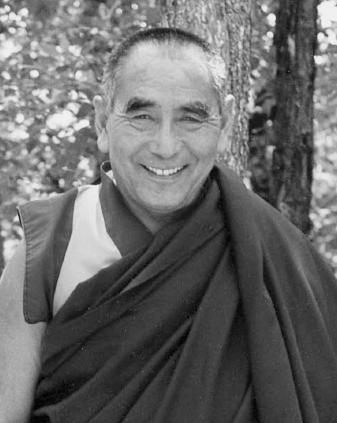
STEPS ON THE PATH TO ENLIGHTENMENT
A Commentary on Tsongkhapas Lamrim Chenmo
Volume 1: The Foundation Practices
Volume 2: Karma
Volume 3: The Way of the Bodhisattva
Volume 4: Samatha
Volume 5: Insight

Foreword
T HE Great Treatise on the Stages of the Path to Enlightenment (Lamrim Chenmo), composed by Tsongkhapa and explained here by Geshe Lhundub Sopa, is a commentary on the Lamp for the Path to Enlightenment, by Atia. The primary goal of these teachings is to discipline and transform the mind. These texts have their source in the sutras and the other teachings of the Buddha himself, but their special virtue is that they convey the thought of the Buddha in a format that is easy to apply in actual practice.
The authors of these wonderful texts composed them in order to help all living beings. Since they developed the altruistic attitude to benet mother sentient beings, we too should follow their example, irrespective of our own weak situation.
The Buddha and the great teachers who followed him gave clear instructions on how to proceed from a state of suffering to a state of peace and happiness. Following such teachings of the great masters of the past, Atia summarized them in his famous text, the Lamp for the Path to Enlightenment. It is a wonderful text, and Atias disciples, such as Dromtonpa and Potowa, put what it teaches into practice. It was then transmitted through the Kadam lineages, nally coming down to Tsongkhapa.
He was an unparalleled scholar, who composed the Great Treatise on the Stages of the Path to Enlightenment, the marvelous text explained here in the manner of the great masters of Nland monastic university. We are indeed fortunate after so much time to have access to such a great work and to be able to read and think about what it contains. With this publication of Geshe Sopas commentary, Tsongkhapas words are brought to life and illuminated for a modern audience, continuing the lineages of scripture and realization that the Buddha set in motion more than 2,500 years ago.
The two principal aspects of practice described here are a proper understanding of emptiness and the awakening mind of bodhicitta. A correct understanding of the view of emptiness is very important, for whether you are taking refuge, or cultivating the awakening mind of bodhicitta, all other practices are enhanced by such an understanding. At the same time, it is extremely important that our insight into the ultimate nature of reality is supported by compassion and the awakening mind of bodhicitta.
In my own case, regardless of my limited capacity, I try my best to develop these two minds: the wisdom understanding emptiness, and bodhicitta the wish to achieve enlightenment for the sake of all sentient beings. Merely trying to approach and cultivate these two minds brings greater peace and happiness. The development of these two minds is really the heart of Buddhist practice. It is the essential meaning of this Stages of the Path to Enlightenment. If we were to examine all the sutras and words of the Buddha, along with the subsequent treatises that are commentaries on them, we would nd that they can be summed up in these two practices. Therefore, we should study these teachings motivated by an aspiration to achieve enlightenment for the sake of all sentient beings.
Today, Buddhism is spreading throughout the Western world, encountering new cultures and new languages. During such a period of transition it is very important that the Dharma be transmitted by scholars and practitioners who possess a deep and vast understanding of the teachings, because that is the only way to protect the authenticity and purity of the teachings.
Atia exemplied this role by bringing the pure teachings from the great monastic centers of North India and establishing them in Tibet in an authentic and complete form that was, at the same time, suitably adapted to the Tibetan personality. He reestablished monasticism in Tibet and emphasized ethical conduct as the heart of Buddhist training. He dispelled the many misconceptions and erroneous customs that had entered the practice of the Dharma in Tibet. In this way he reestablished the pure Buddhadharma in many places where it had been lost, and enhanced it where it survived.
Next page
